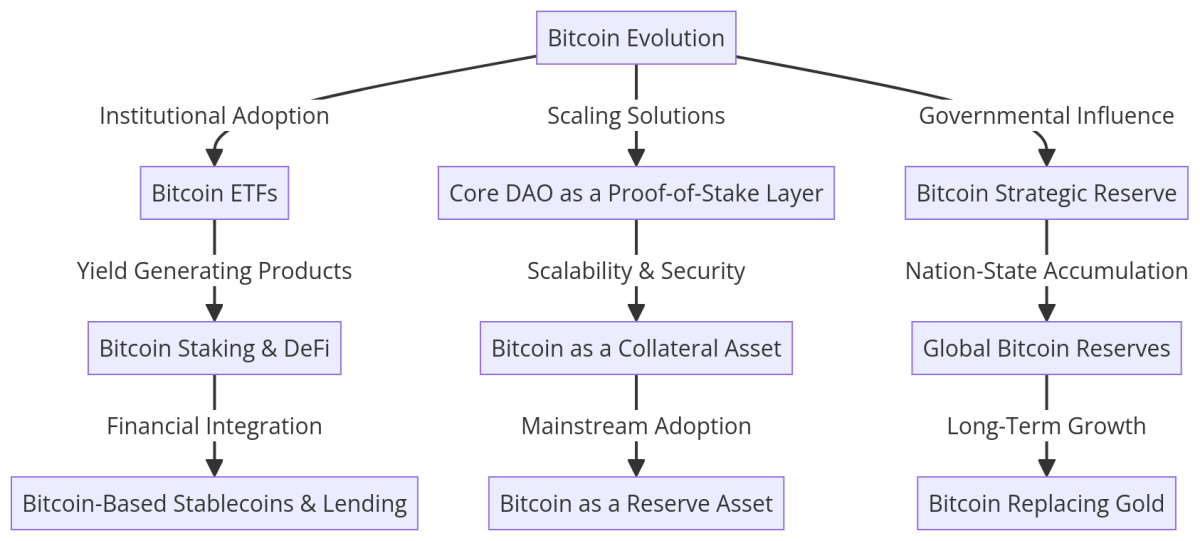Bitcoin
The Future of Bitcoin: Scaling, Institutional Adoption, and Strategic Reserves with Rich Rines
Published
3 months agoon
By
admin
Bitcoin’s evolution from an obscure digital currency to a global financial force has been nothing short of extraordinary. As Bitcoin enters a new era, institutions, governments, and developers are working to unlock its full potential. Matt Crosby, Bitcoin Magazine Pro’s lead market analyst, sat down with Rich Rines, contributor at Core DAO, to discuss Bitcoin’s next phase of growth, the rise of Bitcoin DeFi, and its potential as a global reserve asset. Watch the full interview here: The Future Of Bitcoin – Featuring Rich Rines
Bitcoin’s Evolution & Institutional Adoption
Rich Rines has been in the Bitcoin space since 2013, having witnessed firsthand its transformation from an experimental technology to a globally recognized financial instrument.
“By the 2017 cycle, I was pretty determined that this is what I was going to spend the rest of my career on.”
The conversation delves into Bitcoin’s growing role in institutional portfolios, with spot Bitcoin ETFs already surpassing $41 billion in inflows. Rines believes the institutionalization of Bitcoin will continue to reshape global finance, particularly with the rise of yield-generating products that appeal to Wall Street investors.
“Every asset manager in the world can now buy Bitcoin with ETFs, and that fundamentally changes the market.”
What is Core DAO?
Core DAO is an innovative blockchain ecosystem designed to enhance Bitcoin’s functionality through a proof-of-stake (PoS) mechanism. Unlike traditional Bitcoin scaling solutions, Core DAO leverages a decentralized PoS structure to improve scalability, programmability, and interoperability while maintaining Bitcoin’s security and decentralization.
At its core, Core DAO acts as a Bitcoin-aligned Layer-1 blockchain, meaning it extends Bitcoin’s capabilities without altering its base layer. This enables a range of DeFi applications, smart contracts, and staking opportunities for Bitcoin holders.
“Core is the leading Bitcoin scaling solution, and the way to think about it is really the proof-of-stake layer for Bitcoin.”
By securing 75% of the Bitcoin hash rate, Core DAO ensures that Bitcoin’s security principles remain intact while offering greater functionality for developers and users. With a growing ecosystem of over 150+ projects, Core DAO is paving the way for the next phase of Bitcoin’s financial expansion.
Core: Bitcoin’s Proof-of-Stake Layer & DeFi Expansion
One of the biggest challenges facing Bitcoin is scalability. The Bitcoin network’s high fees and slow transaction speeds make it a powerful settlement layer but limit its utility for day-to-day transactions. This is where Core DAO comes in.
“Bitcoin lacks scalability, programmability. It’s too expensive. All these things that make it a great settlement layer is exactly the reason that we need a solution like Core to extend those capabilities.”
Core DAO functions as a proof-of-stake layer for Bitcoin, allowing users to generate yield without third-party risk. It provides an ecosystem where Bitcoin holders can participate in DeFi applications without compromising on security.
“We’re going to see Bitcoin DeFi dwarf Ethereum DeFi within the next three years because Bitcoin is a superior collateral asset.”
Bitcoin as a Strategic Reserve Asset
Governments and sovereign wealth funds are beginning to view Bitcoin not as a currency but as a strategic reserve asset. The potential for a U.S. Bitcoin strategic reserve, as well as broader global adoption at the nation-state level, could create a new financial paradigm.
“People are talking about building strategic Bitcoin reserves for the first time.”
The idea of Bitcoin replacing gold as a primary store of value is becoming more tangible. Rines asserts that Bitcoin’s scarcity and decentralization make it a superior alternative to gold.
“I think within the next decade, Bitcoin will become the global reserve asset, replacing gold.”
Bitcoin Privacy: The Final Frontier
While Bitcoin is often hailed as a decentralized and censorship-resistant asset, privacy remains a significant challenge. Unlike cash transactions, Bitcoin’s public ledger exposes all transactions to anyone with access to the blockchain.
Rines believes that improving Bitcoin privacy will be a critical step in its evolution.
“I’ve wanted private Bitcoin transactions for a really long time. I’m pretty bearish on it ever happening on the base layer, but there’s potential in scaling solutions.”
While solutions like CoinJoin and the Lightning Network offer some privacy improvements, full-scale anonymity remains elusive. Core is exploring innovations that could enable confidential transactions without sacrificing Bitcoin’s security and transparency.
“On Core, we’re working with teams on potentially having confidential transactions—where you can tell that a transaction is happening, but not the amount or counterparties involved.”
As governments continue to increase scrutiny over digital financial activity, the need for enhanced Bitcoin privacy features will only grow. Whether through native protocol upgrades or second-layer solutions, the future of Bitcoin privacy remains a crucial area of development.
The Future of Bitcoin: A Trillion-Dollar Market in the Making
As the interview progresses, Rines outlines how Bitcoin’s economic framework is expanding beyond speculation and into productive financial instruments. He predicts that within a decade, Bitcoin will command a $10 trillion market cap, with DeFi applications becoming a significant portion of its economic ecosystem.
“The Bitcoin DeFi market is a trillion-dollar opportunity, and we’re just getting started.”
His perspective aligns with a broader industry trend where Bitcoin is not only used as a store of value but also as an active financial asset within decentralized networks.
Rich Rines Roadmap for Bitcoin’s Future

Final Thoughts
The conversation between Matt Crosby and Rich Rines provides a compelling glimpse into the future of Bitcoin. With institutional adoption accelerating, Bitcoin DeFi expanding, and the growing recognition of Bitcoin as a strategic reserve, it is clear that Bitcoin’s best years are ahead.
As Rines puts it:
“Building on Bitcoin is one of the most exciting opportunities in the world. There’s a trillion-dollar market waiting to be unlocked.”
For investors, developers, and policymakers, the key takeaway is clear: Bitcoin is no longer just a speculative asset—it is the foundation of a new financial system.
For more detailed Bitcoin analysis and to access advanced features like live charts, personalized indicator alerts, and in-depth industry reports, check out Bitcoin Magazine Pro.
Disclaimer: This article is for informational purposes only and should not be considered financial advice. Always do your own research before making any investment decisions.
Source link
You may like


Bitcoin (BTC) Yield Platform Coming From Coinbase (COIN), Aspen Digital


The Emerging Market For State Services Via Citizen X


XRP Price Shoots For 20% Surge To $2.51 Amid Pullback To Breakout Zone


Stocks edge higher ahead of big earnings week


Here’s How Bitcoin Could Boost Demand for US Treasuries, According to Macro Guru Luke Gromen


Experts Predict US Recession in 2025 if Trump-China Trade War Tariffs Stay
Bitcoin
Here’s How Bitcoin Could Boost Demand for US Treasuries, According to Macro Guru Luke Gromen
Published
5 hours agoon
April 28, 2025By
admin
Veteran macro investor Luke Gromen says he likes Bitcoin (BTC) due to its potential to influence demand for US Treasuries.
In a new video update, the founder of the macroeconomic research firm Forest for the Trees (FFTT) says the Trump administration is in a position to boost demand for US bonds after the president signed an executive order creating a Strategic Bitcoin Reserve.
A Bitcoin bull market typically increases demand for dollar-pegged crypto assets, and according to Gromen, could ultimately drive demand for US Treasuries.
“Note that the Trump administration is still talking about putting T-bills (Treasury bills) into stablecoins, using stablecoins as a means to drive demand for T-bills. And obviously, they’ve talked about the Strategic Bitcoin Reserve.
Left unsaid in all of that is that the higher the Bitcoin price, the more stablecoin demand, the more T-bill demand there is…
I think the underlying theme of [the] US government desperately needs balance sheet and stablecoins and therefore Bitcoin can help the US government find balance sheet. I think that is absolutely still in play.
It’s one of the reasons why we still like Bitcoin over the intermediate longer term.”
Stablecoin issuers such as Tether and Circle predominantly rely on Treasury bills to back their coins on a 1:1 basis. As of December 2024, Tether has invested over $94.47 billion in T-bills to back USDT. Meanwhile, Circle owns $22.047 billion worth of T-bills as of February of this year to back USDC.
Additionally, two stablecoin bills that are progressing through Congress, the STABLE Act of 2025 and the GENIUS Act of 2025, require issuers to invest in T-bills and other real-world assets to back their coins.
Follow us on X, Facebook and Telegram
Don’t Miss a Beat – Subscribe to get email alerts delivered directly to your inbox
Check Price Action
Surf The Daily Hodl Mix
 

Disclaimer: Opinions expressed at The Daily Hodl are not investment advice. Investors should do their due diligence before making any high-risk investments in Bitcoin, cryptocurrency or digital assets. Please be advised that your transfers and trades are at your own risk, and any losses you may incur are your responsibility. The Daily Hodl does not recommend the buying or selling of any cryptocurrencies or digital assets, nor is The Daily Hodl an investment advisor. Please note that The Daily Hodl participates in affiliate marketing.
Generated Image: Midjourney
Source link
Bitcoin
Monero’s XMR Rockets 40% as XRP Leads Crypto Majors Gains
Published
9 hours agoon
April 28, 2025By
admin

Shaurya is the Co-Leader of the CoinDesk tokens and data team in Asia with a focus on crypto derivatives, DeFi, market microstructure, and protocol analysis.
Shaurya holds over $1,000 in BTC, ETH, SOL, AVAX, SUSHI, CRV, NEAR, YFI, YFII, SHIB, DOGE, USDT, USDC, BNB, MANA, MLN, LINK, XMR, ALGO, VET, CAKE, AAVE, COMP, ROOK, TRX, SNX, RUNE, FTM, ZIL, KSM, ENJ, CKB, JOE, GHST, PERP, BTRFLY, OHM, BANANA, ROME, BURGER, SPIRIT, and ORCA.
He provides over $1,000 to liquidity pools on Compound, Curve, SushiSwap, PancakeSwap, BurgerSwap, Orca, AnySwap, SpiritSwap, Rook Protocol, Yearn Finance, Synthetix, Harvest, Redacted Cartel, OlympusDAO, Rome, Trader Joe, and SUN.
Source link
24/7 Cryptocurrency News
Expert Reveals Why The Ethereum-To-Bitcoin Ratio Is Falling
Published
11 hours agoon
April 28, 2025By
admin
The Ethereum-to-Bitcoin ratio has fallen to its lowest level in five years after a dismal Ethereum price performance. As investors try to wrap their heads around the grim metric, Taproot Wizards co-founder Eric Wall has explained the reason behind the steep drop.
Eric Wall Highlights Reasons For ETH/BTC Ratio Collapse
Taproot Wizards co-founder Eric Wall has identified a raft of reasons behind the decline of the ETH/BTC ratio in 2025. The cryptocurrency expert revealed the factors behind the falling ETH/BTC ratio in an X post, hinging the bulk of the blame on Ethereum’s recent price performance.
The ETH/BTC ratio slumped to a five-year low after Ethereum bucked the trend of following Bitcoin on a rally after the halving event. While Bitcoin price rose to cross the $100K mark, Ethereum price has tumbled below $2,000 to reach lows of $1,400.
For Wall, one factor affecting the ETH/BTC ratio appears to be Ethereum’s position in a competitive landscape. Since its launch, several blockchains have cropped up to snag market share from the largest altcoin, offering cheaper fees and faster processing times.
The cryptocurrency expert argues that the absence of a Saylor-like buyer for ETH is playing its role in the decline of the ETH/BTC ratio. Michael Saylor’s BTC purchases have contributed to the asset’s performance, but Wall argues that Ethereum does not have a consistent buyer.
Wall adds that Bitcoin and gold have evolved into wartime assets in the current macroeconomic climate, while ETH is considered a “peacetime asset.” Gold has surged to new highs, sparking optimism that Bitcoin will follow in the same path for a similar rally, while the Ethereum price continues its unimpressive run.
The Merge Is Not Responsible For The Ratio Decline
Eric Wall notes that Ethereum’s Merge event is not responsible for the ETH/BTC slump, contrary to popular sentiment. Ethereum migrated from Proof-of-Work to Proof-of-Stake in 2022, with the ETH/BTC ratio tanking since the Merge.
“The ETHBTC ratio did not go down because of The Merge,” said Eric Wall.
However, pseudonymous cryptocurrency analyst Beanie argues that the Merge is the primary reason for the price decline. Rebuffing the speculation, Wall opines that Ethereum’s layer 2 tokens triggered network fragmentation after botching the “asset value capture narrative,” affecting the ETH/BTC ratio.
“Ethereum also stagnated into a depressingly small number of defi primitives relative to what past expectations were,” added Wall.
Ethereum is flashing signs of brilliance after ETH trading volume spiked to $17.5 billion in less than a day. ETH prices are exchanging hands at nearly 1,800 after an impressive 12% rally that saw it outperform SOL and XRP
Aliyu Pokima
Aliyu Pokima is a seasoned cryptocurrency and emerging technologies journalist with a knack for covering needle-moving stories in the space. Aliyu delivers breaking news stories, regulatory updates, and insightful analysis with depth and precision. When he’s not poring over charts or following leads, Aliyu enjoys playing the bass guitar, lifting weights and running marathons.
Disclaimer: The presented content may include the personal opinion of the author and is subject to market condition. Do your market research before investing in cryptocurrencies. The author or the publication does not hold any responsibility for your personal financial loss.
Source link

Bitcoin (BTC) Yield Platform Coming From Coinbase (COIN), Aspen Digital

The Emerging Market For State Services Via Citizen X

XRP Price Shoots For 20% Surge To $2.51 Amid Pullback To Breakout Zone

Stocks edge higher ahead of big earnings week

Here’s How Bitcoin Could Boost Demand for US Treasuries, According to Macro Guru Luke Gromen

Experts Predict US Recession in 2025 if Trump-China Trade War Tariffs Stay

Monero Jumps 51% After ‘Suspicious Transfer’ of $333M in Bitcoin

ZachXBT flags suspicious $330M Bitcoin transfer triggering Monero surge

Monero’s XMR Rockets 40% as XRP Leads Crypto Majors Gains

The 5 top crypto loan platforms of 2025

XRP Price Shows Strength — Breakout Above Key Levels Possible?

Expert Reveals Why The Ethereum-To-Bitcoin Ratio Is Falling

Analyst Says Solana-Based Memecoin Going Much Higher, Sees PENGU Facing ‘True Test’ After April Surge

Nike sued for $5 million over its shutdown of NFT platform RTFKT

Biological Age vs. Chronological Age: Redefining Age in the Digital Era

Arthur Hayes, Murad’s Prediction For Meme Coins, AI & DeFi Coins For 2025

Expert Sees Bitcoin Dipping To $50K While Bullish Signs Persist

3 Voting Polls Show Why Ripple’s XRP Price Could Hit $10 Soon

Aptos Leverages Chainlink To Enhance Scalability and Data Access

Bitcoin Could Rally to $80,000 on the Eve of US Elections

Crypto’s Big Trump Gamble Is Risky

Institutional Investors Go All In on Crypto as 57% Plan to Boost Allocations as Bull Run Heats Up, Sygnum Survey Reveals

The Future of Bitcoin: Scaling, Institutional Adoption, and Strategic Reserves with Rich Rines

Sonic Now ‘Golden Standard’ of Layer-2s After Scaling Transactions to 16,000+ per Second, Says Andre Cronje

Ripple-SEC Case Ends, But These 3 Rivals Could Jump 500x

Has The Bitcoin Price Already Peaked?

A16z-backed Espresso announces mainnet launch of core product

Xmas Altcoin Rally Insights by BNM Agent I

Blockchain groups challenge new broker reporting rule

I’m Grateful for Trump’s Embrace of Bitcoin
Trending

 24/7 Cryptocurrency News6 months ago
24/7 Cryptocurrency News6 months agoArthur Hayes, Murad’s Prediction For Meme Coins, AI & DeFi Coins For 2025

 Bitcoin3 months ago
Bitcoin3 months agoExpert Sees Bitcoin Dipping To $50K While Bullish Signs Persist

 Ripple Price1 month ago
Ripple Price1 month ago3 Voting Polls Show Why Ripple’s XRP Price Could Hit $10 Soon

 24/7 Cryptocurrency News4 months ago
24/7 Cryptocurrency News4 months agoAptos Leverages Chainlink To Enhance Scalability and Data Access

 Bitcoin6 months ago
Bitcoin6 months agoBitcoin Could Rally to $80,000 on the Eve of US Elections

 Opinion6 months ago
Opinion6 months agoCrypto’s Big Trump Gamble Is Risky

 Bitcoin6 months ago
Bitcoin6 months agoInstitutional Investors Go All In on Crypto as 57% Plan to Boost Allocations as Bull Run Heats Up, Sygnum Survey Reveals

 Altcoins3 months ago
Altcoins3 months agoSonic Now ‘Golden Standard’ of Layer-2s After Scaling Transactions to 16,000+ per Second, Says Andre Cronje



✓ Share: